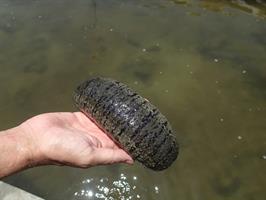“Sometimes it is the people [or animals] no one can imagine anything of who do the things no one can imagine” – Alan Turing
Before joining the MSC UK and Ireland team, I spent several years running a sea cucumber farm in Indonesia. Sea cucumber aquaculture is a relatively new field that has the potential to alleviate pressure on wild stocks and further our scientific understanding of these unique species.“It is hard to love a creature that breathes out of its anus”
As an entrepreneur and a conservationist, I believe there is great business potential in this developing industry and I wanted to play a part in protecting this important, underdog species. Admittedly, it is hard to love a creature that breaths out of its anus, but I confess that after spending several years working closely with sea cucumbers, I have developed a profound respect for them!
What is a sea cucumber?
 The sea cucumber, related to starfish and sea urchins, has more than 1,400 species inhabiting all corners of the marine world, from the ocean floor of Antarctica to the reefs of the tropics. With no eyes or brain, this primitive echinoderm plays a vital biological role in marine ecosystems.
The sea cucumber, related to starfish and sea urchins, has more than 1,400 species inhabiting all corners of the marine world, from the ocean floor of Antarctica to the reefs of the tropics. With no eyes or brain, this primitive echinoderm plays a vital biological role in marine ecosystems. Sea cucumbers predominantly feed on detritus and other organic matter and excrete inorganic nitrogen and phosphorous. This nutrient recycling and sediment redistribution is critical to maintaining productive and biodiverse ecosystems, such as coral reefs. It can also affect alkalinity levels of seawater, serving as an important buffer against ocean acidification.*
What makes the sea cucumber special?
Sea cucumbers have ‘ocean cleaning’ properties which make protecting it vital for maintaining good ocean health.However, at least 70 sea cucumber species are commercially exploited in a multi-billion-dollar trade. Nearly 80 per cent of sea cucumber exports globally are destined for Hong Kong where they are then re-exported into mainland China and sold, typically as a dried product known as bêche de mer.**
Most sea cucumber is harvested for human consumption. Sea cucumber, along with abalone, birds nest soup and totoaba swim bladders, are ‘luxury dishes’ eaten during special occasions such as weddings and Chinese New Year celebrations.
Lauded for medical and health benefits, sea cucumbers have been valued in China since the Ming Dynasty and used in traditional Chinese medicine to treat arthritis and cancer. But it is only recently that scientists have identified bioactive compounds produced by sea cucumbers, and research is being done into the pharmaceutical application of these.
Why are sustainable sources of sea cucumber important?
The high price of sea cucumber has led to high levels of illegal, unreported and unregulated (IUU) fishing, a thriving illegal trade and overfishing in many parts of the world. As China’s middle class is projected to double, from 300 million in 2018 to 600 million by 2022, this upward financial mobility may result in increasing demand for high-end delicacies such as sea cucumber. Sustainable management of wild fisheries will be critical to meet this demand and ensuring a traditional Chinese dish is available for this, and future generations.Continuing to develop our scientific understanding of sea cucumber biology provides opportunities for discovery, potentially, of life saving treatments for humans. The certification of the Western Australia Sea Cucumber Fishery is a major milestone in putting this species on the right track.
You can follow Seth McCurry on Twitter @SethMcCurry2
* Purcell et al. (2016) Ecological Roles of Exploited Sea Cucumbers. Oceanography and marine biology 54:367-386
** Jaquemet, S. and Conand, C. (1999) The Beche-‐de-Mer Trade in 1995‐96 and an Assessment of Exchanges Between the Main World Markets, SPC Beche-de‐Mer Information Bulletin, 12: 11–14.

